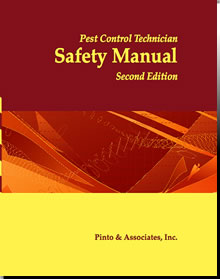 |
| "Listen. I don't care if you find bugs or not. I don't care how many times you've sprayed already. My people are being bitten. Just in the past month, three computer operators have gone to the clinic to be treated for bites and itching. My best telecommunications specialist has filed a grievance with the union. The union rep says get rid of the problem...now...or face a job action. So I'm telling you: Get rid of the problem, now!" |
| Photo © Rosemarie Gearhart/iStockphoto |
Bugs or Not, He Wants You to Spray!
The computer operations manager won't let up. He says spray. But spray what? You still haven't seen a mite or a flea, or any pest that could be biting people in the telecommunications area. Even so, you've treated the area half a dozen times in the last 6 months. You've got a sneaking suspicion you've been caught between that proverbial rock and a hard place.
You're not alone. This conflict -- workers reporting "bites" but no biting pests around -- happens often enough to make life interesting in office building pest control.
These problems are mostly associated with computer rooms, telephone rooms, dispatch rooms, radio rooms and similar sites with a lot of paper, electrical equipment, fibers, and static. The bites are often blamed on "paper mites" or "cable mites" or other fanciful pests.
But, in most cases, people are not simply imagining the bites...and this is an important point to emphasize. Certain conditions in an office environment lead to skin irritation and "pinpricks" that feel like bug bites...and sometimes even look like bug bites.
The major difficulty is convincing workers...who are positive they are being bitten...that they are not. They need to understand that there is a reason for these "bites," even though that reason is not an insect or mite.
If not bugs, what causes the "bites"? Many environmental factors can contribute to irritations and biting sensations:
-
Carpets
- Fibers from synthetic carpets, particularly flimsy, nylon-based carpets, can "leap" onto the legs of office workers. The fibers can feel like pinpricks or bites, and can actually puncture the skin, especially if the person's skin is dry. Women who wear nylons and sandal-type heels have higher static electricity around their legs and feet and are most likely to attract the fibers.
-
Paper Splinters and Particles
- Stacks of paper, multi-part forms, computer cards, and continuous forms produce paper splinters that can cause bite-like sores, rashes, or itching. So too can small pieces of wire insulation, carbon, and particle board. This is where "paper mite" and "cable mite" infestations got their name.
-
Static Electricity
- High levels of static electricity can make carpet fibers, particles, and paper splinters "jump" to oppositely-charged arms or legs. Nylon rugs generate static electricity when people walk or roll their chairs. Electrical equipment such as radios, terminals, consoles, and computers also generate static.
-
Low Humidity
- Low humidity increases static electricity and the movement and effect of paper splinters, carpet fibers, and other particles, and aggravates dry skin as well.
-
Ventilation
- Filters from heating and air conditioning systems, and fiberglass insulation around ductwork, sometimes release fibers that cause "bites" and irritation. New filters often release fibers for a few days after installation. Dead spots in air flow within a room may increase skin irritation and the feeling that one is being bitten.
-
Indoor Air Pollutants
- Modern buildings with closed ventilation systems sometimes have periodic high levels of chemical pollutants such as formaldehyde and resins. Some of these can cause skin irritations or allergic reactions.
-
Insecticide Treatment
- Repeated insecticide appplications may increase workers' skin irritation and sensitivity to other environmental factors. (There is a "Catch-22" here. Office managers may insist on repeated insecticide treatments. Sometimes an area gets short-term relief from "bites" caused by fibers or other physical irritants after it has been sprayed because (1) sprays or fogs can carry dust and fiber particles down into the carpet, and (2), sprays add moisture to the air and lower static electricity levels. But these effects are short-term, and the repeated exposures may increase the skin problems.)
-
Weekends Outdoors
- Workers may be bitten on weekend picnics or other outdoor activities. Mosquito, fly, chigger, or flea bites may not show up for several hours, and in fact may be noticed first at work where they are blamed on "bugs in the office." Workers may pick up head lice from their children.
-
Bell's Syndrome
- This syndrome demonstrates the "power of suggestion." When one person in a group feels an itch or biting sensation or irritation, and begins to talk about it or to scratch, others in the group soon follow suit. It is a very powerful suggestion, difficult to ignore. When one person in an office talks about "bites," it will likely influence others.
What Can Be Done About "Mystery Bugs"?
 |
| There are no such pests as "paper mites" or "cable mites" that bite office workers! |
| Photo © Brenda McEwan/iStockphoto |
Guess what? There are no such things as "paper mites" or "cable mites." And you should not treat if there aren't any pests. (But first you must make sure there aren't any pests, of course, such as bird mites, fleas, or thrips.) Here's where your communication skills come into play.
Explain to your client that the situation is not unique. Tell him about the possible environmental causes for the problem. Give him articles (like this one) about "mystery bugs." If he doesn't believe you, suggest that he hire a pest control consultant or industrial hygienist for an independent assessment.
Here are some things that your client can do to reduce environmental causes of "mystery bites."
- Workers should be told that the "bites" are not being caused by bugs, but by a combination of environmental factors (fibers, static, etc.) that are being corrected. Do not tell them the bites are "imaginary," because they're not.
- Vacuum the area with a powerful vacuum to remove as many fibers and particles as possible. Wall/floor junctions, table legs, and crevices should be vacuumed using a crevice tool. Table tops and the areas under computers and equipment should be wiped down with a mild soap solution.
- Worn nylon carpeting should be removed. Either leave the floor bare, or replace with new carpet treated to prevent static build-up. Avoid bottom-of-the-line nylon carpets since they release large numbers of fibers. Carpets should be vacuumed often.
- Install antistatic rubber pads under rolling chairs and antistatic pads under electrical equipment.
- Workers should avoid strong soaps, repellents, or similar irritating solutions. Skin moisturizers and lotions can help those with dry skin. Antistatic spray can be applied to nylon stockings and chairs.
- Apply no insecticides in the affected areas unless pests are seen and verified.
- If problems continue, have an industrial hygienist inspect the rooms and air vents for chemicals (such as formaldehyde), low humidity levels, irritating fibers, high static levels, and other conditions that could be contributing to the problem.
More...
Pest Control's Role in Classic Delusions of Parasitosis
For a PDF file of a recent (10/22/06) article in Techletter, click Inspection Sheet—Delusory Parasitosis

